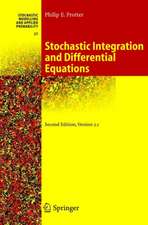Nonlinear Oscillations of Hamiltonian PDEs: Progress in Nonlinear Differential Equations and Their Applications, cartea 74
Autor Massimiliano Bertien Limba Engleză Hardback – oct 2007
After introducing the reader to classical finite-dimensional dynamical system theory, including the Weinstein–Moser and Fadell–Rabinowitz bifurcation results, the author develops the analogous theory for nonlinear wave equations. The theory and applications of the Nash–Moser theorem to a class of nonlinear wave equations is also discussed together with other basic notions of Hamiltonian PDEs and number theory. The main examples of Hamiltonian PDEs presented include: the nonlinear wave equation, the nonlinear Schrödinger equation, beam equations, and the Euler equations of hydrodynamics.
This text serves as an introduction to research in this fascinating and rapidly growing field. Graduate students and researchers interested in variational techniques and nonlinear analysis applied to Hamiltonian PDEs will find inspiration in the book.
Din seria Progress in Nonlinear Differential Equations and Their Applications
-
 Preț: 281.13 lei
Preț: 281.13 lei - 15%
 Preț: 643.34 lei
Preț: 643.34 lei - 18%
 Preț: 735.38 lei
Preț: 735.38 lei - 18%
 Preț: 893.40 lei
Preț: 893.40 lei - 18%
 Preț: 1129.99 lei
Preț: 1129.99 lei - 15%
 Preț: 586.23 lei
Preț: 586.23 lei - 18%
 Preț: 1128.57 lei
Preț: 1128.57 lei - 18%
 Preț: 903.21 lei
Preț: 903.21 lei - 18%
 Preț: 788.54 lei
Preț: 788.54 lei - 18%
 Preț: 784.13 lei
Preț: 784.13 lei -
 Preț: 399.12 lei
Preț: 399.12 lei - 15%
 Preț: 640.71 lei
Preț: 640.71 lei - 18%
 Preț: 1012.84 lei
Preț: 1012.84 lei - 18%
 Preț: 1010.17 lei
Preț: 1010.17 lei - 18%
 Preț: 953.97 lei
Preț: 953.97 lei -
 Preț: 383.33 lei
Preț: 383.33 lei - 15%
 Preț: 586.85 lei
Preț: 586.85 lei - 5%
 Preț: 657.34 lei
Preț: 657.34 lei - 15%
 Preț: 635.47 lei
Preț: 635.47 lei -
 Preț: 386.61 lei
Preț: 386.61 lei -
 Preț: 402.56 lei
Preț: 402.56 lei - 15%
 Preț: 704.36 lei
Preț: 704.36 lei - 15%
 Preț: 519.47 lei
Preț: 519.47 lei -
 Preț: 386.00 lei
Preț: 386.00 lei -
 Preț: 391.02 lei
Preț: 391.02 lei -
 Preț: 393.90 lei
Preț: 393.90 lei - 18%
 Preț: 954.93 lei
Preț: 954.93 lei -
 Preț: 387.96 lei
Preț: 387.96 lei - 15%
 Preț: 644.82 lei
Preț: 644.82 lei - 18%
 Preț: 890.37 lei
Preț: 890.37 lei - 15%
 Preț: 642.18 lei
Preț: 642.18 lei -
 Preț: 391.99 lei
Preț: 391.99 lei - 18%
 Preț: 966.15 lei
Preț: 966.15 lei - 18%
 Preț: 789.35 lei
Preț: 789.35 lei
Preț: 644.63 lei
Preț vechi: 758.38 lei
-15% Nou
Puncte Express: 967
Preț estimativ în valută:
123.34€ • 128.80$ • 101.86£
123.34€ • 128.80$ • 101.86£
Carte tipărită la comandă
Livrare economică 15-29 aprilie
Preluare comenzi: 021 569.72.76
Specificații
ISBN-13: 9780817646806
ISBN-10: 0817646809
Pagini: 180
Ilustrații: XIV, 180 p. 10 illus.
Dimensiuni: 155 x 235 x 17 mm
Greutate: 0.54 kg
Ediția:2007
Editura: Birkhäuser Boston
Colecția Birkhäuser
Seria Progress in Nonlinear Differential Equations and Their Applications
Locul publicării:Boston, MA, United States
ISBN-10: 0817646809
Pagini: 180
Ilustrații: XIV, 180 p. 10 illus.
Dimensiuni: 155 x 235 x 17 mm
Greutate: 0.54 kg
Ediția:2007
Editura: Birkhäuser Boston
Colecția Birkhäuser
Seria Progress in Nonlinear Differential Equations and Their Applications
Locul publicării:Boston, MA, United States
Public țintă
ResearchCuprins
Finite Dimension.- Infinite Dimension.- A Tutorial in Nash–Moser Theory.- Application to the Nonlinear Wave Equation.- Forced Vibrations.
Recenzii
From the reviews:
"After discussing important problems and introducing general techniques for Hamiltonian PDEs, the book under review focuses on the nonlinear wave equation. The point of view the author takes is a dynamical system perspective, giving the maximal priority to the search for invariant objects. … Some nice remarks and useful tools … are collected in the appendices. This monograph is written with high rigor and good taste and it may conveniently win the attention of both advanced researchers and graduate students." (Enrico Valdinoci, Mathematical Reviews, Issue 2008 i)
"After discussing important problems and introducing general techniques for Hamiltonian PDEs, the book under review focuses on the nonlinear wave equation. The point of view the author takes is a dynamical system perspective, giving the maximal priority to the search for invariant objects. … Some nice remarks and useful tools … are collected in the appendices. This monograph is written with high rigor and good taste and it may conveniently win the attention of both advanced researchers and graduate students." (Enrico Valdinoci, Mathematical Reviews, Issue 2008 i)
Textul de pe ultima copertă
Many partial differential equations (PDEs) that arise in physics can be viewed as infinite-dimensional Hamiltonian systems. This monograph presents recent existence results of nonlinear oscillations of Hamiltonian PDEs, particularly of periodic solutions for completely resonant nonlinear wave equations.
After introducing the reader to classical finite-dimensional dynamical system theory, including the Weinstein–Moser and Fadell–Rabinowitz resonant center theorems, the author develops the analogous theory for completely resonant nonlinear wave equations. Within this theory, both problems of small divisors and infinite bifurcation phenomena occur, requiring the use of Nash–Moser theory as well as minimax variational methods. These techniques are presented in a self-contained manner together with other basic notions of Hamiltonian PDEs and number theory.
This text serves as an introduction to research in this fascinating and rapidly growing field. Graduate students and researchers interested in nonlinear variational techniques as well in small divisors problems applied to Hamiltonian PDEs will find inspiration in the book.
After introducing the reader to classical finite-dimensional dynamical system theory, including the Weinstein–Moser and Fadell–Rabinowitz resonant center theorems, the author develops the analogous theory for completely resonant nonlinear wave equations. Within this theory, both problems of small divisors and infinite bifurcation phenomena occur, requiring the use of Nash–Moser theory as well as minimax variational methods. These techniques are presented in a self-contained manner together with other basic notions of Hamiltonian PDEs and number theory.
This text serves as an introduction to research in this fascinating and rapidly growing field. Graduate students and researchers interested in nonlinear variational techniques as well in small divisors problems applied to Hamiltonian PDEs will find inspiration in the book.
Caracteristici
Introductory treatise to the current research in the field Includes an appendix that discusses the basic noties of Hamiltonian PDEs and number theory












